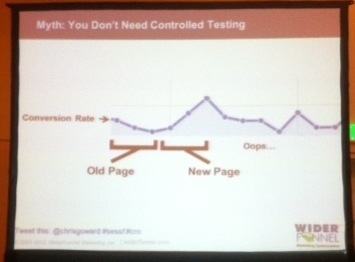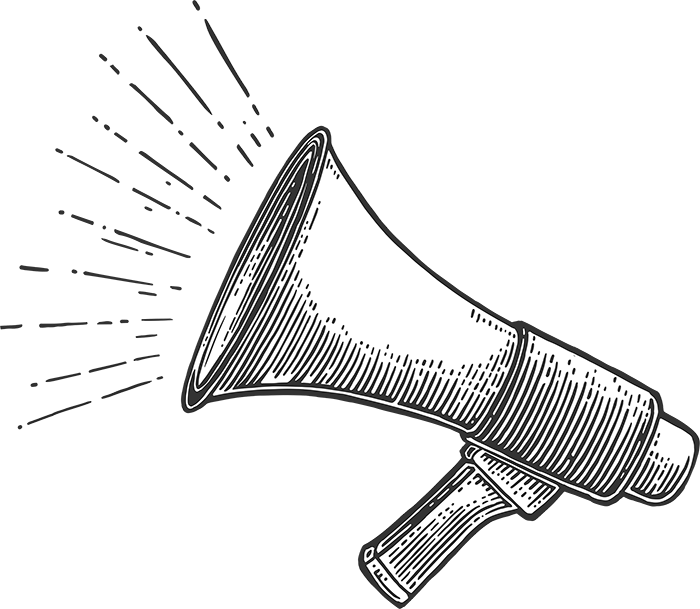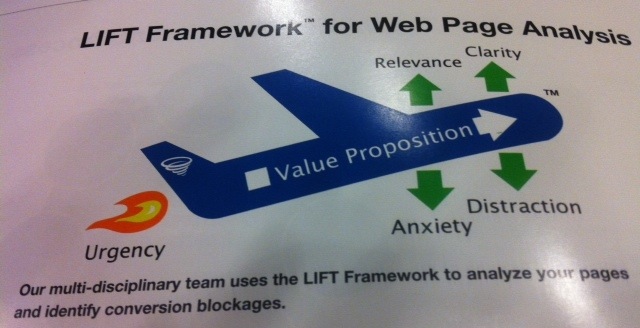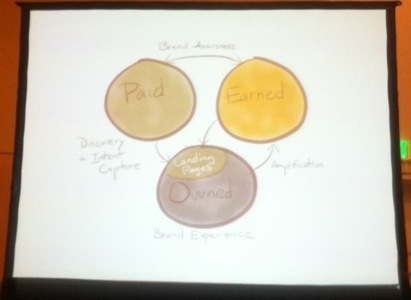Optimizing Landing Pages for Conversion and Revenue
Moderator:
Bryan Eisenberg, SES Advisory Board; NYTimes Bestselling Author, bryaneisenberg.com
Speakers:
Scott Brinker, President & Chief Technology Officer, ion interactive
Chris Goward, Co-Founder and CEO, WiderFunnel Marketing Optimization
A testing game to test your conversion skills, care of Chris, our first speaker.
A Wine Deal Website
The goal: More e-commerce revenue
Why: Millions of daily emails to opt-in list
Testing 2 variations of a landing page from a daily email. The call to action box in the right corner is the only variation. One had a larger add to cart button and a large red “on sale now” headline. The version with the smaller button had a 5% conversion rate lift and a 41% revenue per visitor lift. Turns out their audience is a sophisticated audience who comes for tasting notes videos. The more the landing page smelled like marketing, the more turned off they were. Is this an unusual audience? Marketing insights from testing will show.
You have thousands of visitors coming to your site waiting to show you how to persuade them.
Correcting Misconceptions about CRO
Myth: Best practices advice gives best results.
Myth: Green buttons work best. Red buttons work best. Orange buttons work best.
Truth: Winning buttons depend on context!
Hair Club
The goal: More lead gen form fills
Testing 2 pages, one variation is emotive (beautiful women) while the other is static (a description of services available).
The static version resulted in a 20% conversion rate lift.
This points to another myth.
Myth: Sex sells.
Truth: Sex is distracting.
Myth: Multivariate testing gives the best results.
Truth: Spend 10% on tools, 90% on people.
You can’t put weak ideas into a tool and get brilliant results.
Myth: You don’t need controlled testing.
 |
Preimposed tests are worthless. The amount of fluctuation that happens overwhelms.
Real conversion optimization is the intersection of 3 things:
1. Persuasion marketing
2. Experience design
3. Scientific method
How does it work? The framework works across industries.
Knowing what to test: Using the LIFT model.
Positive lift comes from:
Value proposition (search “WiderFunnel Lift” for more)
Relevance strengthens the proposition. Don’t let your scent trail disappear.
Clarity: this includes eye flow, call to action and more. Don’t try to be too clever with your images.
While conversion drops can come from:
Anxiety can detract from the lift. It’s anything that causes questions of trust.
Distraction will pull away the user’s intent on performing the conversion.
Urgency is like a rocket booster on the back of the lift.
Scott comes up next. Landing pages are at an intersection of content marketing, performance marketing and technical wizardry. But sadly, most landing pages suck, usually for 2 reasons: no one thought about it or the only thing on the person’s mind was getting a conversion.
Landing pages like the latter are like aggressive pickup lines. This is death to your brand. You lose the chance to make a great impression. The advice?
Stop thinking about landing pages. Consumers don’t think about landing pages. Instead, think of experiences.
You are not limited to one page. Break out of the landing page cliche.
A microsite is a few pages linked together. He uses Intuit GoPayment as an example. The user can say, okay, show me a little more.
Taking the space of a microsite to serve up content before asking for conversion will build up trust.
Multi-page conversion experiences can also be a decision tree. Check out California Closets. You choose what you’re interested, build your own story. It’s directed exploring that will bring someone to something of interest to them. Another example is The New England Journal of Medicine.
Progressive conversion is another muti-page conversion experience. BlueCross BlueShield does this in 3 steps: ZIP code, number of employees, and then contact info. At the point of contact info the page is very tailored for the visitor, it outlines some of the options that will be available to them.
Owned media is getting rich. It’s a huge potential resource that with a little more creativity can open up a new experience for your customers.

2 Replies to “Optimizing Landing Pages for Conversion and Revenue”
Hi, Virginia,. Thanks for synopsizing this presentation. I find the LIFT model pretty intriguing, particularly the relationship between anxiety and relevance. Where was this event held?
Hi Scott :) This session was part of the SES Conference (formerly Search Engine Strategies) in San Francisco. Check out our team round-up for other big highlights of the show: http://www.bruceclay.com/blog/2012/08/ses-san-francisco-2012-recap/
LEAVE A REPLY











